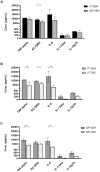Mouse pneumonia model by Acinetobacter baumannii multidrug resistant strains: Comparison between intranasal inoculation, intratracheal instillation and oropharyngeal aspiration techniques
- PMID: 34855837
- PMCID: PMC8638993
- DOI: 10.1371/journal.pone.0260627
Mouse pneumonia model by Acinetobacter baumannii multidrug resistant strains: Comparison between intranasal inoculation, intratracheal instillation and oropharyngeal aspiration techniques
Abstract
Infectious pneumonia induced by multidrug resistant (MDR) Acinetobacter baumannii strains is among the most common and deadly forms of healthcare acquired infections. Over the years, different strategies have been put in place to increase host susceptibility to MDR A. baumannii, since only a self-limiting pneumonia with no or limited local bacterial replication was frequently obtained in mouse models. Direct instillation into the trachea or intranasal inoculation of the bacterial suspension are the techniques used to induce the infection in most of the preclinical models of pneumonia developed to date. More recently, the oropharyngeal aspiration procedure has been widely described in the literature for a variety of purposes including pathogens administration. Aim of this study was to compare the oropharyngeal aspiration technique to the intranasal inoculation and intratracheal instillation in the ability of inducing a consistent lung infection with two MDR A. baumannii clinical isolates in immunocompromised mice. Moreover, pneumonia obtained by bacteria administration with two out of three techniques, intratracheal and oropharyngeal, was characterised in terms of histopathology of pulmonary lesions, biomarkers of inflammation level and leukocytes cells infiltration extent after mice treatment with either vehicle or the antibiotic tigecycline. The data generated clearly showed that both strains were not able to colonize the lungs when inoculated by intranasal route. By contrast, the bacterial load in lungs of mice intratracheally or oropharyngeally infected significantly increased during 26 hours of monitoring, thus highlighting the ability of these strains to generate the infection when directly instilled into the lower respiratory airways. Furthermore, the intragroup variability of mice was significantly reduced with respect to those intranasally administered. Tigecycline was efficacious in lung bacterial load and cytokines release reduction. Findings were supported by semi-quantitative histopathological evaluation of the pulmonary lesions and by inflammatory biomarkers analysis. To conclude, both intratracheal instillation and oropharyngeal aspiration techniques showed to be suitable methods for inducing a robust and consistent pneumonia infection in mice when difficult MDR A. baumannii clinical isolates were used. Noteworthy, oropharyngeal aspiration not requiring specific technical skills and dedicated equipment, was proven to be a safer, easier and faster technique in comparison to the intratracheal instillation.
Conflict of interest statement
The authors have declared that no competing interests exist.
Figures





Similar articles
-
In vivo efficacy of combination of colistin with fosfomycin or minocycline in a mouse model of multidrug-resistant Acinetobacter baumannii pneumonia.Sci Rep. 2019 Nov 20;9(1):17127. doi: 10.1038/s41598-019-53714-0. Sci Rep. 2019. PMID: 31748527 Free PMC article.
-
Intranasal treatment with bacteriophage rescues mice from Acinetobacter baumannii-mediated pneumonia.Future Microbiol. 2016 May;11:631-41. doi: 10.2217/fmb.16.11. Epub 2016 Feb 29. Future Microbiol. 2016. PMID: 26925593
-
Acid aspiration provokes the pneumonia caused by multidrug-resistant Acinetobacter baumannii in BALB/c mice.Int J Infect Dis. 2013 Jun;17(6):e454-60. doi: 10.1016/j.ijid.2013.01.022. Epub 2013 Mar 20. Int J Infect Dis. 2013. PMID: 23522637
-
Treatment of Acinetobacter infections.Expert Opin Pharmacother. 2010 Apr;11(5):779-88. doi: 10.1517/14656561003596350. Expert Opin Pharmacother. 2010. PMID: 20210684 Review.
-
Drug treatment for multidrug-resistant Acinetobacter baumannii infections.Future Microbiol. 2008 Dec;3(6):649-60. doi: 10.2217/17460913.3.6.649. Future Microbiol. 2008. PMID: 19072182 Review.
Cited by
-
Intratracheal Aerosolization of Nocardia farcinica in Mice Optimizes Bacterial Distribution and Enhances Pathogenicity Compared to Intranasal Inoculation and Intratracheal Instillation.Biomolecules. 2025 Jun 30;15(7):950. doi: 10.3390/biom15070950. Biomolecules. 2025. PMID: 40723822 Free PMC article.
-
Using an Aluminum Hydroxide-Chitosan Matrix Increased the Vaccine Potential and Immune Response of Mice against Multi-Drug-Resistant Acinetobacter baumannii.Vaccines (Basel). 2023 Mar 16;11(3):669. doi: 10.3390/vaccines11030669. Vaccines (Basel). 2023. PMID: 36992253 Free PMC article.
-
Predatory bacteria can intensify lung-injury in a multidrug-resistant Acinetobacter baumannii pneumonia model in rat.Front Microbiol. 2025 Jan 23;16:1512119. doi: 10.3389/fmicb.2025.1512119. eCollection 2025. Front Microbiol. 2025. PMID: 39916860 Free PMC article.
-
Aerosolized delivery of ESKAPE pathogens for murine pneumonia models.Sci Rep. 2024 Jan 31;14(1):2558. doi: 10.1038/s41598-024-52958-9. Sci Rep. 2024. PMID: 38297183 Free PMC article.
-
Therapeutic Prospection of Animal Venoms-Derived Antimicrobial Peptides against Infections by Multidrug-Resistant Acinetobacter baumannii: A Systematic Review of Pre-Clinical Studies.Toxins (Basel). 2023 Apr 3;15(4):268. doi: 10.3390/toxins15040268. Toxins (Basel). 2023. PMID: 37104206 Free PMC article.
References
-
- Dexter C, Murray GL, Paulsen IT and Peleg AY. 2015. Community acquired Acinetobacter baumannii: clinical characteristics, epidemiology and pathogenesis. Expert Rev. Anti-Infect. Ther. 2005; 13: 567. - PubMed
MeSH terms
Substances
LinkOut - more resources
Full Text Sources
Medical
Molecular Biology Databases

